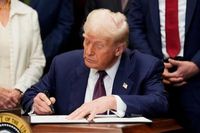On August 1, 2025, Thailand reached a significant milestone in its trade relations with the United States, as Deputy Prime Minister and Finance Minister Pichai Chunhavajira confirmed a new reciprocal tariff agreement that sets import duties on Thai goods entering the U.S. at 19%. This rate matches that of Cambodia and marks a substantial reduction from the previous 36%, signaling a fresh chapter in economic diplomacy between the two nations.
The announcement comes amid heightened geopolitical and economic pressures, including recent border tensions between Thailand and Cambodia, which U.S. President Donald Trump personally intervened in, urging a ceasefire. Trump's involvement underscored the strategic importance of the region and its trade dynamics, linking political stability with economic negotiations.
Minister Pichai emphasized that the tariff discussions focused solely on economic and trade matters, explicitly excluding issues related to national security or natural gas concessions. He stressed that the Thai negotiation team was intent on securing terms that would enhance Thailand’s competitiveness globally. The 19% tariff, he noted, positions Thai exports more favorably against rival countries, offering a competitive edge that could lower production costs and benefit both consumers and exporters.
“This is good news that from now on, Thai exports to the U.S. will face a tariff rate of 19%, a level that can compete with other countries,” Pichai said, adding that the government intends to present the detailed negotiation report to the Cabinet and later to Parliament for approval.
Despite this progress, Pichai acknowledged the challenges ahead. Thailand must ramp up its competitiveness by lowering production costs and focusing on high value-added goods that meet market demand. He outlined a vision where local content is increased, small and medium-sized enterprises (SMEs) are integrated into supply chains, and new production structures emphasize domestic capabilities.
One thorny issue is the problem of transshipment goods—products routed through third countries to evade tariffs. The U.S. applies a hefty 40% import tax on such goods if they contain less than 40% Thai local content, which Thailand views as a disadvantage and is actively working to address. The government plans to tighten origin verification processes, with the Ministry of Commerce becoming the sole authority issuing certificates of origin, and customs authorities in both countries cooperating closely to curb abuse.
Thailand’s approach to market access for U.S. goods is measured. Contrary to some perceptions, the country has not agreed to open its markets fully at zero tariffs. Instead, it has negotiated selective concessions, often involving products already covered under existing free trade agreements with other countries such as Australia and China. Investments are also being negotiated reciprocally, with a focus on areas where Thailand has readiness and strengths, particularly in processed agricultural products.
Regarding specific commodities, Pichai detailed plans for corn imports, a vital input for animal feed. Thailand consumes about 10 million tons annually but produces only half domestically. The government will implement a quota system that prioritizes purchasing corn from Thai farmers first, then from neighboring countries like Myanmar, Laos, and Cambodia, and finally from the U.S., which offers the lowest cost. This tiered approach balances domestic agricultural support with market efficiency.
On fishmeal, Pichai expressed confidence that U.S. imports would not disrupt the market due to significantly higher costs—10 to 20 times more than local products—making it unlikely for American fishmeal to flood Thai markets. Pork imports from the U.S. will be allowed only on a very limited scale, possibly under 1% of domestic consumption, with stringent inspections to prevent the use of banned substances such as red meat accelerators.
Energy imports are also a focus. Thailand currently imports 90% of its oil globally, with plans to increase imports from the U.S. to around 10%, or 120,000 barrels. For natural gas, which Thailand imports about 50% of, long-term contracts with Middle Eastern suppliers are gradually expiring, opening potential for U.S. imports that could lower electricity costs.
In aviation, Thai Airways is planning to purchase 80 to 90 new Boeing aircraft over the next 5 to 10 years, resuming a fleet expansion halted during the COVID-19 pandemic. This aligns with mutual interests, as both Thailand and the U.S. look to strengthen aviation ties.
The reciprocal tariff agreement is part of a broader U.S. strategy under President Trump to recalibrate trade relations with multiple countries. On July 31, 2025, Trump signed an executive order raising import tariffs on goods from several nations, including Japan. For Japan, the base tariff rate was set at 15%, reflecting recent negotiations and a compromise between previous rates. Japanese officials expressed cautious optimism that the new tariffs and agreements would reduce uncertainty in U.S. trade policy and mitigate risks to both the Japanese and global economies.
Back in Southeast Asia, the U.S. has also adjusted tariffs for other ASEAN countries. Laos and Myanmar face 40% tariffs, down from even higher initial rates, while Vietnam’s rate dropped to 20%. Indonesia, the Philippines, Cambodia, and Malaysia have tariffs set around 19-25%, depending on prior agreements and negotiations. Singapore’s tariff remains steady at 10%, reflecting its unique trade status.
Deputy Prime Minister and Interior Minister Bhumitham Wechayachai, acting as interim Prime Minister, convened a special Cabinet meeting to discuss the implications of the new U.S. tariffs. The government coordinated closely with U.S. counterparts, with a joint working group drafting the agreement that required Cabinet approval before public release.
The tariff changes are set to take effect on August 7, 2025, with goods shipped before that date still subject to the previous 10% tariff rate. This transition period offers some breathing room for exporters and importers to adjust.
Looking ahead, Thailand faces the critical task of ensuring that the new tariff regime translates into sustainable economic benefits. Minister Pichai emphasized that growth in GDP for 2025 depends on multiple factors, including global economic conditions and domestic efforts to boost competitiveness. The government’s multifaceted approach—spanning tariff negotiations, production upgrades, and regulatory reforms—aims to position Thailand as a resilient player in the evolving global trade landscape.
In sum, the new reciprocal tariff deal with the U.S. marks a strategic win for Thailand, balancing competitive access to a key market with protections for domestic industries and farmers. It underscores the complex interplay of diplomacy, economics, and policy as nations navigate an increasingly interconnected yet challenging global economy.


